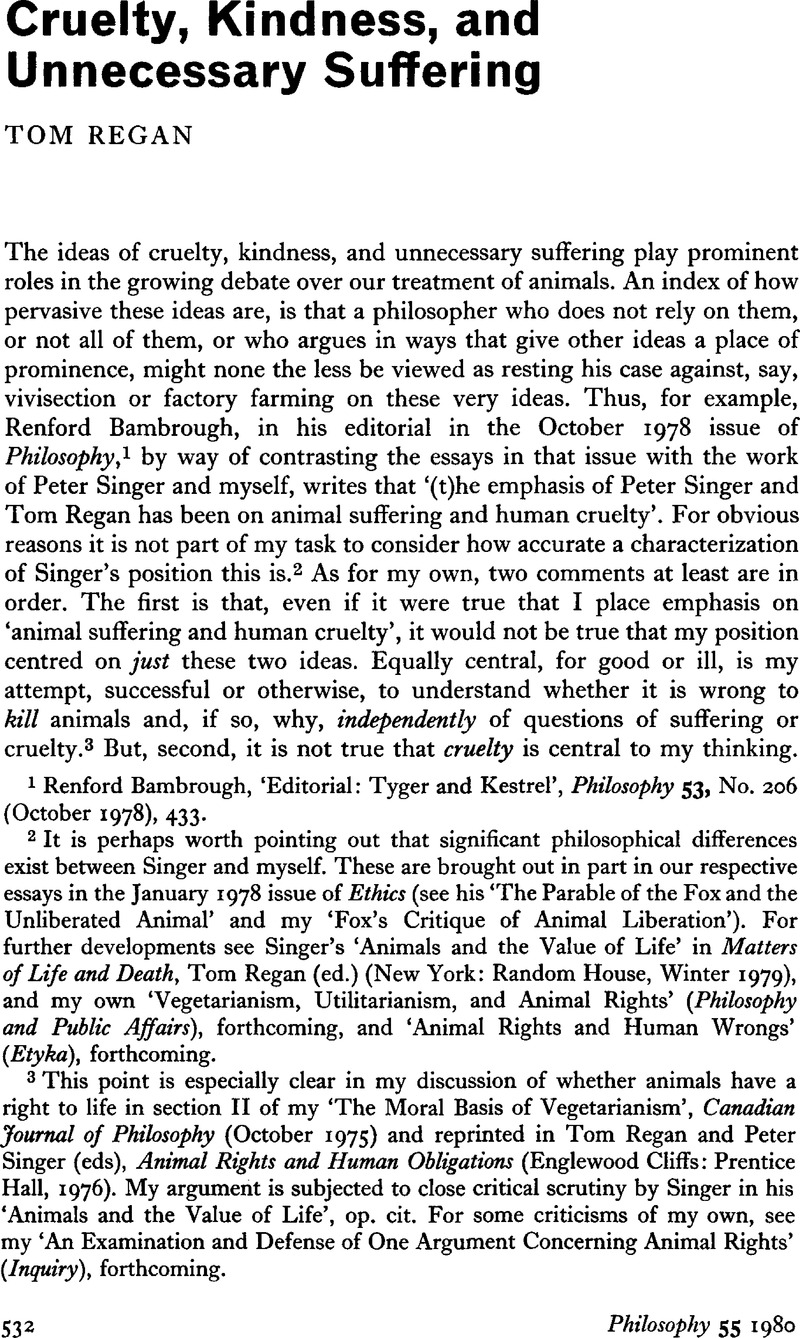Article contents
Cruelty, Kindness, and Unnecessary Suffering
Published online by Cambridge University Press: 30 January 2009
Abstract

- Type
- Discussion
- Information
- Copyright
- Copyright © The Royal Institute of Philosophy 1980
References
1 Bambrough, Renford, ‘Editorial: Tyger and Kestrel’, Philosophy 53, No. 206 (10 1978), 433.Google Scholar
2 It is perhaps worth pointing out that significant philosophical differences exist between Singer and myself. These are brought out in part in our respective essays in the January 1978 issue of Ethics (see his ‘The Parable of the Fox and the Unliberated Animal’ and my ‘Fox's Critique of Animal Liberation’). For further developments see Singer's ‘Animals and the Value of Life’ in Matters of Life and Death, Regan, Tom (ed.) (New York: Random House, Winter 1979)Google Scholar, and my own ‘Vegetarianism, Utilitarianism, and Animal Rights’ (Philosophy and Public Affairs), forthcoming, and ‘Animal Rights and Human Wrongs’ (Etyka), forthcoming.
3 This point is especially clear in my discussion of whether animals have a right to life in section II of my ‘The Moral Basis of Vegetarianism’, Canadian Journal of Philosophy (10 1975)Google Scholar and reprinted in Regan, Tom and Singer, Peter (eds), Animal Rights and Human Obligations (Englewood Cliffs: Prentice Hall, 1976)Google Scholar. My argument is subjected to close critical scrutiny by Singer in his ‘Animals and the Value of Life’, op. cit. For some criticisms of my own, see my ‘An Examination and Defense of One Argument Concerning Animal Rights’ (Inquiry), forthcoming.
4 I have touched on the ideas of kindness and unnecessary suffering elsewhere. For a brief discussion of the former, see my ‘Exploring the Idea of Animal Rights’ in Animal Rights: A Symposium, Patison, D. and Ryder, R. (eds) (London: Centaur Press, 1979)Google Scholar; for the latter see ‘On the Right to be Spared Gratuitous Suffering’ (Canadian Journal of Philosophy), forthcoming.
5 Locke writes as follows:
One thing I have frequently observed in Children, that when they have got possession of any poor Creature, they are apt to use it ill: They often torment, and treat very roughly, young Birds, Butterflies, and such other poor Animals, which fall into their Hands, and that with a seeming kind of Pleasure. This I think should be watched in them, and if they incline to any such Cruelty, they should be taught the contrary Usage. For the Custom of Tormenting and Killing Beasts, will, by Degrees, harden their Minds even towards Men; and they who delight in the Suffering and Destruction of Inferior Creatures, will not be apt to be very compassionate, or benign to those of their own kind… (Locke, John, Some Thoughts Concerning Education, 5th edn (London: printed for A. and C. Churchill, 1905)Google Scholar. See also Axfell, James (ed.) The Educational Writings of John Locke (Cambridge: Cambridge University Press, 1968), sec. 116, 225–226).Google Scholar
The general approach to our duties to animals suggested by this passage—namely, that our duties to animals are indirect duties to humankind—I label ‘the Kantian account’ and subject it to criticism in my ‘Exploring the Idea of Animal Rights’, op. cit. In an earlier examination of cruelty I failed to distinguish the brutal sense. See my ‘Animal Rights and Human Wrongs’, op. cit. Discussions with Professor James Nickel have been very beneficial in this regard.
6 I argue this point in the essays cited earlier and am especially indebted to Joel Feinberg's work on related topics. See especially his ‘The Rights of Animals and Unborn Generations’ in Philosophy and Environmental Crisis, Blackstone, W. (ed.) (Athens: University of Georgia, 1974).Google Scholar
7 See, especially, ‘The Moral Basis of Vegetarianism’, op. cit.
8 Diamond, Cora, ‘Eating Meat and Eating People’, Philosophy 53, No. 206 (10 1978), 470.CrossRefGoogle Scholar
9 Ibid., 478.
10 Ibid., 468.
11 On this point, see my ‘On the Right to be Spared Gratuitous Suffering’, op. cit.
12 The Draize test, named after its inventor, is a test used to determine the eye-irritancy of various products (e.g. toothpaste or talcum powder). Rabbits are a common test subject, since they lack tear ducts and thus are unable to rinse substances from their eyes or dilute them. Concentrated solutions of the test substance are allowed to drip into one of the rabbit's eyes; the other eye is let alone. Redness, swelling, loss of cornea or iris, degree of blindness, extent of ulceration, etc., are measured and the eye-irritancy of the test substance is thereby established. There is a growing movement to bring a halt to such tests. The point I try to make in the body of the essay is that the case for stopping tests like this one does not depend on the tests themselves or those who conduct them being cruel.
13 See, especially, ‘The Moral Basis of Vegetarianism’, op. cit.
14 I want to thank Dale Jamieson for his helpful criticisms of an earlier draft of this essay.
- 12
- Cited by




